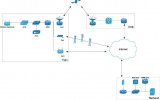
-
StatusOngoing
-
Status date2014-12-09
Objectives
- Use a more efficient satellite technology permitting the use of the Adaptive Coding and Modulation (ACM) in both the forward link and the return link for a better space segment efficiency
- Improve reacquisition time of the satellite system (modem) after long shadow zones
- Develop a more robust TCP and HTTP acceleration system to be able to handle satellite link with high end-to-end delays adapted to cope with the type of traffic used by the train users
- Better QoS implementation in order to discriminate different typologies of traffic;
- Aggregate links of different nature (e.g. terrestrial and satellite) with different end-to-end delays in order to make them acting as one aggregated link
Challenges
- Making ACM work in both Forward and Return link in a mobile environment with frequent obstacles
- Cellular and satellite link are different, it will be a challenge to make them work together with generic components sourced from third parties
- Organising a pilot on a commercial train.
Benefits
The main benefits for 21Net and its customers would be:
- increasing the availability of the “Internet on board” service
- improving the final user experience
- minimizing the cost per bit ratio
Features
The 21Net system architecture relies on two-way Ku-band satellite transmission to provide connectivity between the internet backbone and the train. The satellite operator selected for the project is Hispasat.
The system is composed of three key subsystems: the train, the HUB and the backend.
The train subsystem is composed of:
- The Access Control Gateway (ACG), which contains the Authentication, Authorization en Accounting (AAA) and the on board portal
- The Mobile Access Router (MAR), dedicated to route traffic to the satellite or to the terrestrial link
- The Accelerator (ACC), to optimise the TCP connection efficiency even with high latency link
- The Satellite modem (SAT) used for the Satellite connections
- The Cellular Modem (Cell) used to connect to multiple cellular network providers
The HUB for the satellite modem is hosted by Hispasat.
The backend hosts at the 21Net service centre the units corresponding to the MAR and the ACC, together with the filtering System.
The project will address the following developments:
- ACC: Improvement of the efficiency of the “acceleration system”
- MAR: Bonding of the link using different access technologies (cellular, satellite, WiFi)
- SAT: By the adoption of a new modem (iDirect) we expect to succeed in using ACM technology in both the forward and the return link at an improved cost/bit ration; during the project the link control will be customised for the train environment
- Filtering system: Application consuming high bandwidth will be filtered to avoid congestions
Plan
The project is divided in three main stages:
- First stage: development and static test in the lab
- Second stage: testing in mobile environment complemented with development and test in lab
- Third stage: going live for a Pilot of 1 month on a commercial train
All the main activities are conducted by 21Net.
Current status
The CDR meeting has been successfully carried out in June 2014, which marked the completion of trade-off and design activities.
In the process of the design, opportunities for additional developments have been identified, which would respond to the performance limitations encountered in the configuration selected in the original architecture.
The new satellite solution is looking promising, and substantial improvements with respect to the previous solution are expected.
Acceptance tests of the system are expected to take place in July 2014.




